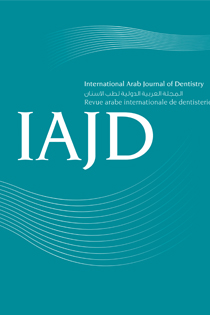Abstract
The aim of this study was to compare the microtensile bond strength of 3 bulkfill composites with 2 polymerisation modes: continuous and progressive.
Twenty-four healthy human molars were occlusally reduced by 4 mm (Exakt Technology Inc Kg of Norderstedt, Germany), etched with 35% phosphoric acid for
15 seconds, then a layer of adhesive was applied. Each group received 1 type of bulkfill composite : 1) group 1 (n=6): Smart dentin replacement “SDR™” (Dentsply / Caulk®, Milford, DE, USA); 2) group 2 (n=6): Tetric N Ceram® bulk fill “TNC®” (Ivoclar, Vivadent, Schaan Germany) and 4) group 4 (n=6): a nano-hybrid composite Z250 XT (3M, ESPE, Seefeld, Germany). Each group underwent two types of polymerization (n = 3): continuous polymerization and ramping polymerization. Each
tooth was then cut into sections of 1 mm2. Specimens were hooked to a universal machine YL-01 (YLE GmbH Waldstraße 1/1a, 64732 Bad König, Germany) and a pulling force was applied to each specimen at a speed of 1 mm/min.
This study showed that with LED continuous polymerization mode or ramping polymerization mode, the average tearing force was significantly different between the 4 types of composites (p = 0.006 < 0.05, p < 0.0001, respectively). The mean value of tearing was the following: TNC® < FB < Z250XT < SDR™.
Finally, the average tearing force was significantly different between the bulkfill composites when using the same type of polymerization. The value of tearing is always lower in continuous polymerization in comparison to the ramping polymerization. SDR™ had the lowest value of retraction and polymerization stress when
compared to the TNC® and FB, resulting in a better adaptation of the restoration. Furthermore, while comparing the 2 types of polymerization, we concluded that the ramping mode gives less retraction and polymerization stress than the continuous mode, thereby, a better adaptation of restoration.

